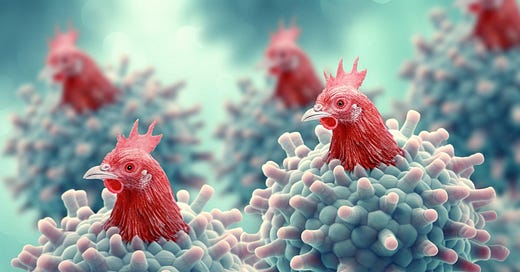The “Avian Flu” was first identified in Chinese geese in 1996, then quickly spread globally to a wide variety of bird species. H5N1 Avian Influenza has reoccurred regularly, but human cases have only recently been identified. This paper investigates the potential risks to humans from a new pandemic.
The Centers for Disease Control and Prevention (CDC) rate the H5N1 strain as Highly Pathogenic Avian Influenza (HPAI). A large fraction of the tens of millions of domestic birds that have died were intentionally “culled” (slaughtered and buried) in an ineffective effort to stop the spread.
The U.S. Agriculture Department in a 2015 outbreak in the Continental United States forced ranchers to cull 50 million domestic birds. Worldwide Avian Flu culls since 2022 resulted deaths of over a half a billion birds, with U.S. ranchers culling about 82 million birds. There are no reliable wild bird Avian Flu death estimates, but it probably exceed 20 million birds annually.
It is believed that the main vector for transmitting Avian Flu has been through infected migratory water birds dropping their feces into open waters, irrigation trenches and animal watering troughs.
There is no evidence that the H5N1 strain of Avian Flu that is currently circulating in American birds is highly pathogenic or lethal in either cattle other mammals. There have been numerous Avian Flu transfers to mammals since 2022, including 67 cattle herds, one human exposed to infected poultry, and three humans that were in close contact with infected cattle. But there have been no sustained H5N1 strain human hospitalizations, human-to-human transfers, or deaths.
Cattle infected with H5N1 develop mild, temporary symptoms, which include decreased milk production. But given the almost universal pasteurization of cows’ milk prevented would have prevented contagion from all Avian Flu virus strains, it is unclear how long since the virus first infected cattle.
Contrary to speculative articles in the New York Times, Business Insider and other main-stream-media outlets, there have been no Avian Flu human transmissions through consumption of unpasteurized milk and cheese.
The H5N1 infectious strain can persist on solid surfaces, including the rubber and stainless steel fittings on dairy milking machines. But claims that milking machines spread H5N1 to other cattle are speculative at best.
With epidemiologists finding no evidence of airborne transmission of Avian Flu by cattle and current effectiveness of food safety measures regarding poultry and milk production, it is rated highly unlikely Avian Flu will enter the human food supply.
Regardless of the science, the Biden Administration’s on July 2nd signed a $176 million to contract with Moderna Inc (NASDAQ: MRNA) funded U.S. Biomedical Advanced Research and Development Authority to complete late-stage development and testing of a pre-pandemic mRNA-based vaccine against H5N1 Avian Influenza.





Thank you for this article. Looks like they are trying to make another tempest in a teapot,
For all these viruses they created we probablly all have the antibodies just like Sars Covid 2